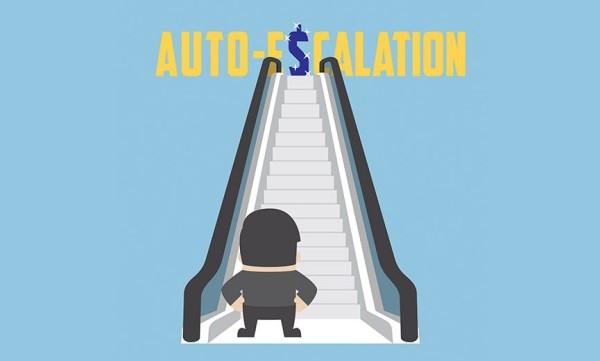
¿Ayuda la escalación automática a los trabajadores a ahorrar para la jubilación?
It’s difficult to get experts to agree on something, but there seems to be a universal consensus that, on average, American workers will contribute a bare minimum to their retirement plans unless they have an incentive to do otherwise.
But the future is starting to look a bit brighter here as advisors see automated features moving the contributions needle.
Since the Pension Protection Act of 2006, auto-enrollment rates have steadily increased; one report shows a nearly 13 percent increase over the past four years in plans boasting auto-enrollment. Even more encouraging is that researchers found that “the prevalence of automatic contribution escalation (63.2%) increased significantly compared to previous years: 2015 (45.9%)1”.
While the news is good, the average deferral amount still hovers in the low 4 percent range, well below the industry-recommended retirement contribution of 10 percent of pretax earnings.
Alex Assaley, managing principal at AFS 401(k) Retirement Services, says the 3 to 6 percent range for automatic enrollment deferral starting points and maximum increase has been the historical default for most organizations.
“Retirement committees can suffer from inertia with their plan design, leaving automatic provisions to start at 3 percent and only escalate to an eventual 6, which leaves most investors saving at a level too low for their retirement income needs” he says.
Instead, companies should resist the status quo and become bold and courageous in a quest to help employees save more. He encourages advisors to utilize complementary data points, research and their client’s specific demographic data to help shape plan design – specifically, automatic enrollment and provisions for increasing contributions.
Assaley says that good, old-fashioned competition between employees works wonders, as well.
When he shows average retirement rates for peer groups both inside and outside of the company -- and where employee “X” stands in comparison with peers, he says, “we can create a ‘gamification’ and challenge aspect that helps create yearning for people to do better.”
Stephen Wendel, Ph.D., agrees. As head of Morningstar’s Behavioral Science division, Wendel spends his days examining the nuances that can spur or suppress investor action.
“Peer comparisons are motivating because, if you see that you are saving less than average relative to your peer group, you may want to increase your deferrals to keep up,” he says. “Conversely, if you are doing better than the average person in your situation, you may still want to push yourself even higher, to be in that top 10 percent group.”
In other words, if it’s possible for them, it’s possible for you.
Wendel starts with the premise that, overall, most employees feel no inherent urgency about retirement savings. They want to save, but simple inertia makes even trivial decisions difficult to make -- which is why he believes that auto-enrollment is a powerful tool that can help overcome this challenge.
Assaley believes that the comparison tactic works well at the retirement committee level, too. When decision-makers see their savings numbers falling below those of their direct competitors, it can be very effective in persuading them to move to a higher auto-enrollment starting point, which could lead to higher escalation points.
“As a company, they don’t want to be a late mover,” he says “They don’t want to lag.”
Some companies believe that automated retirement features could be considered invasive and are concerned about a negative response from employees. But Assaley says that, very often, there is little to no backlash.
“Employees generally have positive feelings toward auto-enrollment and related functions,” he says
Advisors cannot rely on auto-enrollment alone, says Wendel, because it still doesn’t help participants see the money as “theirs.” Instead, he says, you need to engage employees so they feel their saving has a purpose.
To illustrate, he tells a story: If you put $10 in your wallet to buy something special for someone, and in the meantime, you see something you want for yourself, you’ll be less likely to reallocate that $10 from its original purpose.
The same applies to retirement savings.
“When an employee changes jobs and they feel that their retirement savings to date has a purpose, they won’t be as willing to cash it out when they leave,” he says.
He also points to something he calls “just-in-time decision-making” – essentially, that advisors need to intervene and give “detailed guidance in that flashpoint moment” when employees are thinking about the money – specifically, when they have a choice to cash out or roll it into a new plan during a job change.
The government also has a role in increasing retirement savings amounts, Assaley says: The Department of Labor could loosen ERISA guidelines and provide better Safe Harbor protections.
“Auto enrollment creates additional administration as well as fiduciary risk,” he says. “The DOL could adjust regulations so if a company missed auto-enrolling an employee, the corrections process wouldn’t be quite so cumbersome.”
Despite calls to make 401(k) enrollment fully automatic, the government needs to stop short of this mandate, says Assaley.
Wendel also believes that mandatory 401(k) enrollment is not warranted. As a society, he says, we are comfortable with providing defaults with the option to leave.
“But the freedom to choose must always remain,” he says.
1 https://www.callan.com/wp-content/uploads/2017/01/Callan-2017-DC-Survey.pdf - Cited with permission
Este sitio web contiene artículos publicados por su valor informativo y educativo. Paychex no es responsable de la información contenida en ninguno de estos materiales. Ninguna de las opiniones expresadas en los materiales es necesariamente opinión de Paychex ni recibe el respaldo de Paychex. La información en estos materiales no debe considerarse como un asesoramiento legal o contable y no debe sustituir al asesoramiento legal, contable o profesional de otro tipo en casos en los que los hechos y las circunstancias lo justifiquen.